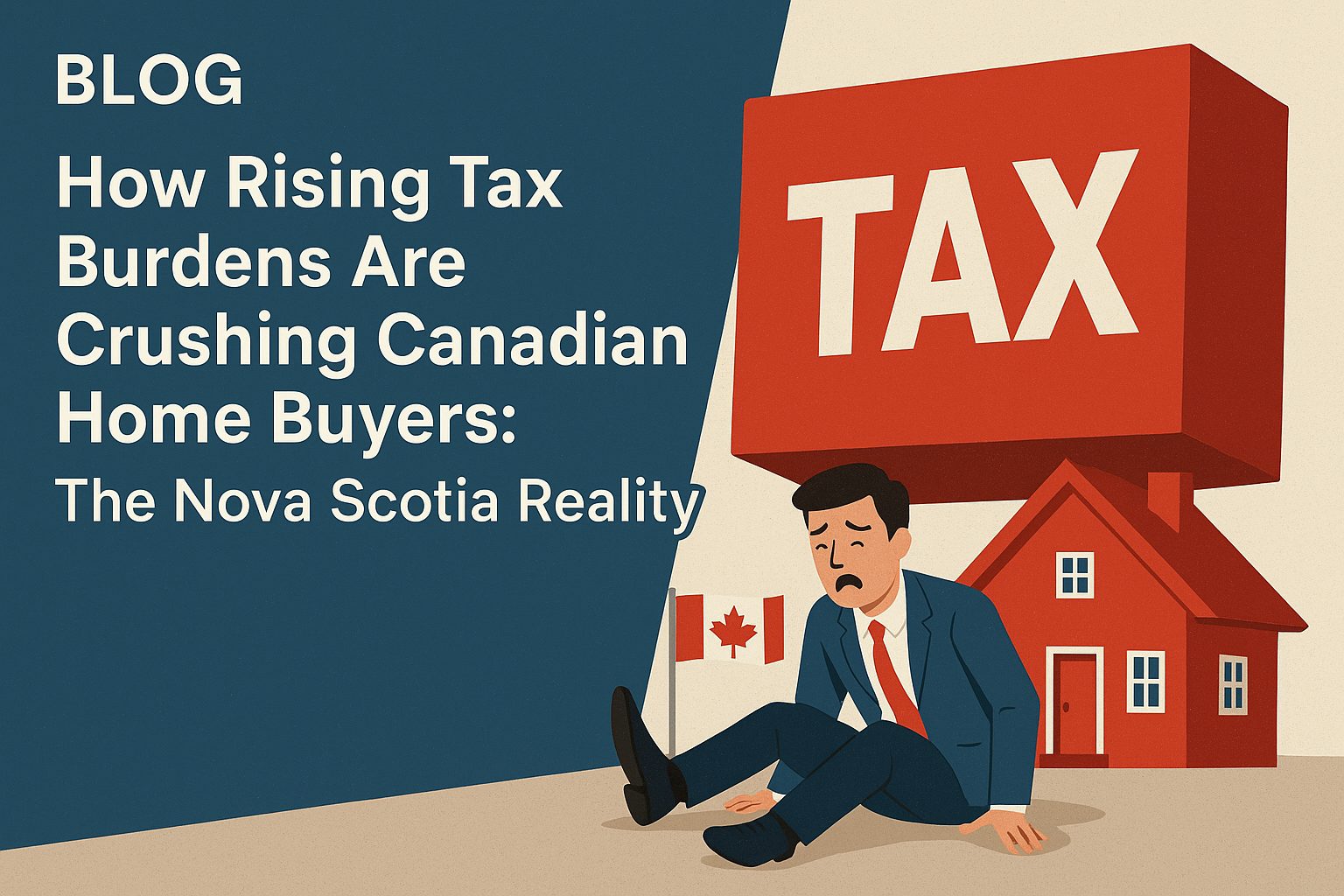How Canada’s Soaring Tax Burden is Crippling Homeownership Dreams — Especially in Nova Scotia
Canadian families now spend 42.3% of their income on taxes—more than they spend on housing, food, and clothing combined. This growing tax burden is making homeownership harder to achieve, hitting first-time buyers the hardest and intensifying housing affordability challenges across Canada, including Nova Scotia’s fast-rising real estate market.
Taxes Now Cost More Than Life’s Essentials
According to the Fraser Institute’s 2025 Canadian Consumer Tax Index, the average Canadian household now spends more on taxes than on their most basic needs.
Here’s the breakdown:
-
42.3% of income goes toward taxes (federal, provincial, and municipal)
-
35.5% goes toward housing, food, and clothing—combined
-
The average tax bill for a Canadian family earning $114,289 is $48,306
Since 1961, tax growth has skyrocketed:
-
Taxes: +2,784%
-
Housing: +2,129%
-
Food: +927%
-
Clothing: +460%
-
Inflation (CPI): +925%
These numbers tell a clear story: Canadian families are paying more than ever—often at the expense of their ability to buy a home.
How Canada Compares Globally
When it comes to tax burdens, Canada is near the top of the list.
| Country | Tax Burden (%) |
|---|---|
| Belgium | 44.8% |
| Canada | 42.3% |
| France | 41.0% |
| Germany | 40.9% |
| OECD Average | 29.5% |
| United States | ~25% |
| Switzerland | 17.1% |
| South Korea | 18.3% |
| New Zealand | 18.6% |
| Chile | 4.4% |
Compared to other developed countries, Canadian families:
-
Pay 12.8 percentage points more than the OECD average
-
Face one of the highest tax burdens in the world
-
Have significantly less after-tax income to put toward housing
The Double Squeeze: High Taxes + High Housing Costs
While high taxes are eating up income, housing prices in many Canadian markets continue to climb. This creates a painful double hit to affordability.
1. Shrinking Buying Power
With nearly half of household income going to taxes, there’s less left for down payments, mortgage payments, and upkeep. Even as interest rates stabilize, homebuyers aren’t catching a break—because taxes are taking the first cut.
2. Development Taxes Drive Up Home Prices
In Ontario, taxes now make up 36% of the price of a newly built home. That’s up from 31% just three years ago.
For a home priced at $1,070,000, taxes and fees can total $381,000—including:
-
Income tax on earnings used for the down payment
-
HST/GST
-
Land transfer taxes
-
Development charges and municipal fees
These costs get passed to buyers, pushing prices even higher.
3. Supply Constraints from High Development Costs
High development charges reduce builder margins and stall new construction—just when we need more housing supply to meet demand. Less supply = higher prices.
Nova Scotia: Affordable No More?
Record-High Prices in 2025
Nova Scotia’s housing market continues to heat up:
-
Provincial average (May 2025): $493,136 (+6.1% YoY)
-
Halifax average: $626,156 (+5% YoY)
-
Inventory: Just 2.3 months, signaling a strong seller’s market
Affordability Concerns Are Mounting
-
66% of Nova Scotians report housing affordability issues
-
41% say they are “very concerned” about future housing costs
-
Halifax’s homeless population reached 3,295 in March 2025
Even traditionally affordable markets are becoming out of reach.
Government Response: Too Little, Too Late?
Nova Scotia has introduced some measures to help:
-
HST cut: From 15% to 14% starting April 1, 2025
-
Increased personal tax credits
-
Non-resident deed transfer tax doubled to 10%
But these may be overshadowed by:
-
A projected $898-million deficit for 2025-26
-
A rising debt-to-GDP ratio, expected to hit 40.9% by 2028
Without deeper reform, meaningful relief remains unlikely.
Who’s Feeling the Squeeze?
First-Time Homebuyers
They face the toughest road:
-
Taxes take a huge chunk out of savings
-
Lower after-tax income reduces mortgage eligibility
-
A $450,000 home can carry an effective tax burden of 45.2%
Move-Up Buyers
Existing homeowners trying to upgrade face:
-
Land transfer taxes
-
Legal fees
-
Capital gains tax (if applicable)
-
Higher annual property taxes
Investors
Large landlords and REITs are under pressure from:
-
Increased taxes on non-resident buyers
-
Speculation taxes in some provinces
-
Reduced tax breaks for real estate investments
Regional Trends & the National Picture
-
Ontario and BC: Most unaffordable; sales expected to lag behind
-
Atlantic Canada: Strong price growth but still more affordable than Toronto or Vancouver
-
Nova Scotia home prices: Still 65% above pre-pandemic levels
-
Rent: Halifax saw a 4.8% YoY increase in Dec 2024
What Needs to Change: Policy Solutions
✅ Tax Reform
-
Reduce development charges
-
Expand personal tax exemptions
-
Simplify housing-related taxes
-
Study tax-efficient countries (e.g., Switzerland, Korea)
✅ Increase Housing Supply
-
Invest in infrastructure to support growth
-
Reform zoning to allow more density
-
Streamline development approval processes
✅ Stabilize the Market
-
Support first-time buyers with enhanced programs
-
Target speculative and non-resident buyers
-
Incentivize purpose-built rental developments
What’s Next for 2025 and Beyond?
Short-Term (2025–2026)
-
MLS® sales projected to increase slightly
-
Housing starts expected to slow (especially for condos)
-
Modest interest rate cuts could offer some relief
Medium-Term (2026–2028)
-
Canada needs 430,000–480,000 new homes annually to restore affordability
-
Rising government debt may restrict future tax cuts
-
Climate adaptation costs will add pressure to housing costs
Long-Term Outlook
-
Federal role: Income tax reform + infrastructure investment
-
Provinces: Zoning reform + streamlined development
-
Municipalities: Smarter land use and fairer development charges
-
Private sector: Innovative construction and financing models
Final Thoughts: Taxes Are the Hidden Housing Crisis
The dream of homeownership in Canada is slipping out of reach—not just because of high prices or mortgage rates, but because of taxes that quietly erode buying power.
When families spend more on taxes than food, housing, and clothing combined, it’s time to rethink our priorities.
Even in Nova Scotia—once a refuge of affordability—families are being squeezed. Home prices continue to climb, and housing insecurity is rising.
The key takeaway? If you’re buying or selling in 2025, tax planning is as important as your mortgage rate. Understanding the full cost of homeownership—including the layers of tax—has never been more critical.
Need Help Navigating Nova Scotia’s Real Estate Market?
Whether you’re a first-time buyer, investor, or selling your home, it’s never been more important to understand how tax policy and affordability trends impact your decisions.
📞 Reach out to Keith Kenny, Century 21 Optimum Realty — your trusted local expert in Halifax and beyond.
Keywords optimized for SEO: Canadian tax burden, Nova Scotia real estate 2025, housing affordability crisis, homeownership in Canada, Halifax housing prices, taxes on Canadian homebuyers, development charges Canada, first-time buyer challenges, real estate trends Nova Scotia.

 Facebook
Facebook
 X
X
 Pinterest
Pinterest
 Copy Link
Copy Link

